Or more specifically, nudibranchs and Christmas tree worms.
Nudibranchs are, roughly speaking, sea slugs. That doesn't sound very exciting if you think of land slugs. But nudibranchs come in an amazing assortment of shapes and colors. A better equivalent might be the butterflies of the sea.
The word "nudibranch" means roughly "naked gills". That's the bushy thing you can see on their backs.

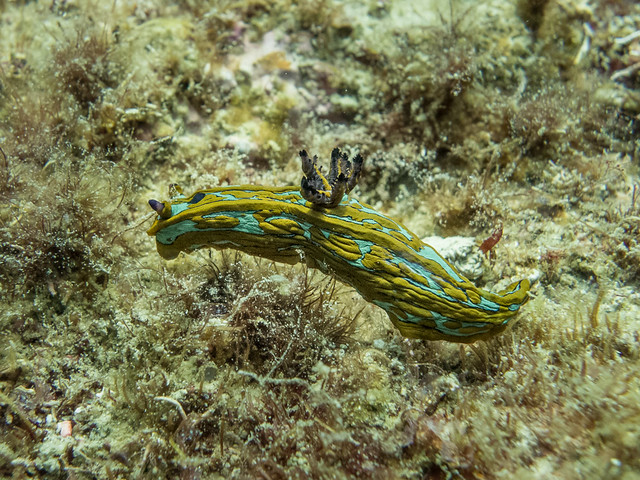
One good thing about photographing nudibranchs is that they don't move too fast. Although even a slow crawl can take them out of sight when you're fiddling with camera settings and trying not to drift away.
This one isn't as sharp as I'd like, but it's the best I got of this type. We didn't see many of these.
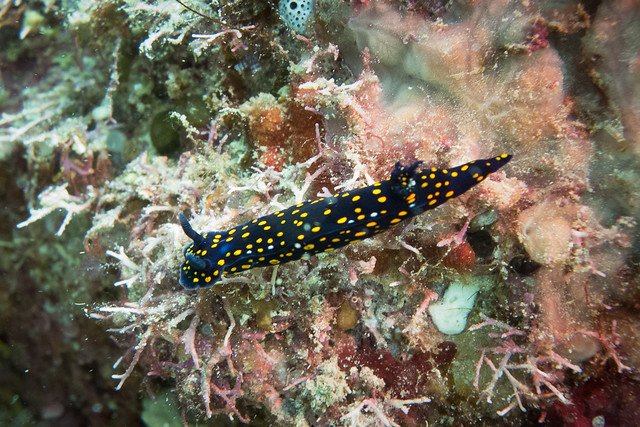
It takes skill and experience to spot the nudibranchs, just like an expert birdwatcher will see more birds. Rafael (our dive master) is very good at it. We also had another guy diving with us, John, whose main interest was nudibranchs. Where I might spot one or two on a dive, he would see a dozen different kinds. (He had little interest in boring things like fish!) Rafael and John were also spotting ones that were tiny, e.g. less than a centimeter (half an inch) long. I didn't even try to spot (or photograph) those ones. The ones I have photos of were maybe 5 cm (2 inches).
The Tiger dorid (Roboastra tigris) below is one of the largest, growing up to 30 cm (12 inches) in length. The name fits both the coloring and its predatory behavior. It will even eat other nudibranchs, swallowing them whole.
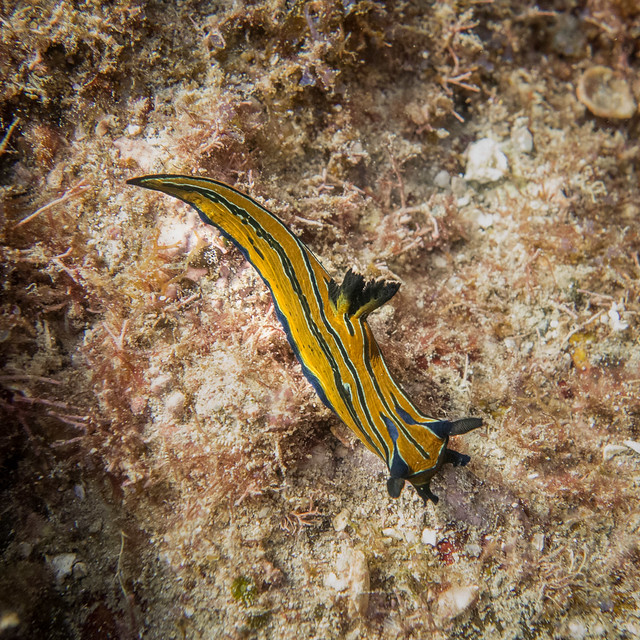
I shared this photo previously from our earlier dives. This was the only one of this type that we've seen so far.

[update] We saw a couple more of these later. They were "flatter" than the first one.
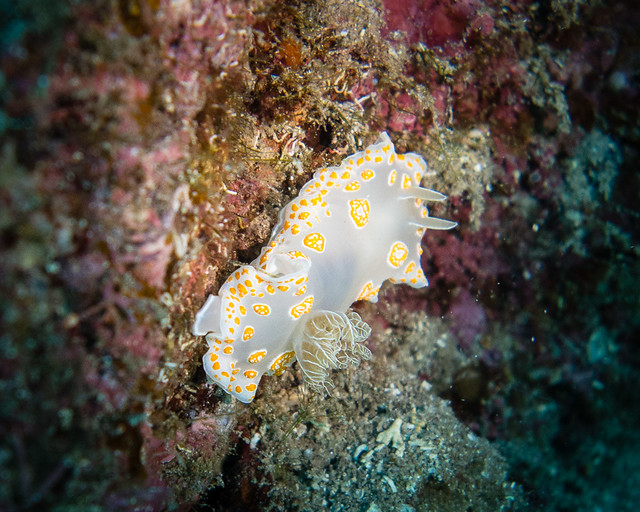
[update] We also saw a few Agassiz's nudibranchs. I tried to get a better angle instead of straight overhead or from the side.
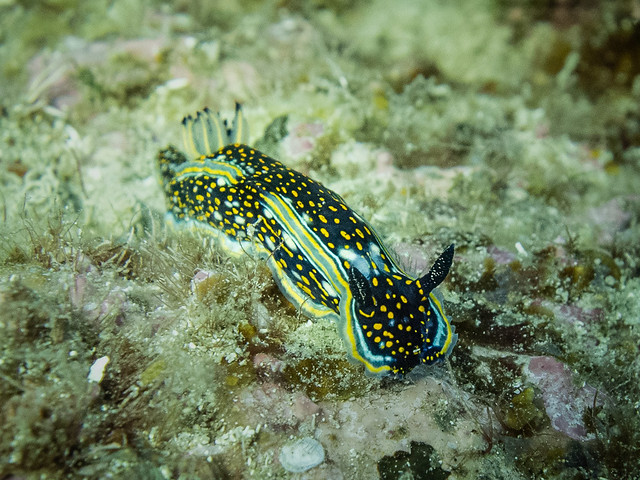
These next ones are related but they have a partial shell - a cone shaped "hat". They are side-gill snails because they have their gills on one side instead of on top like the nudibranchs. The photo is not the clearest, but there are two of them together, possibly mating?

See all my nudibranch photos from this trip
"worms" doesn't sound very appealing, but Christmas tree worms are beautiful. You don't actually see the worm, just their feeding and respiration structure - a spiral that can be a variety of colors. If you get too close the worms retract this structure instantly, making it tricky to photograph them sometimes - if you get too close you end up with nothing to photograph. A bit of current seems to help, probably because it "hides" your movement.
This blue color is less common but stands out because there aren't a lot of things that color.
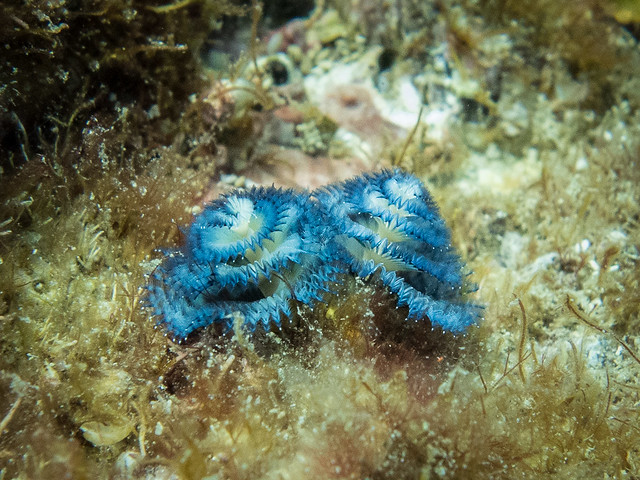
They are often found in groups. Sometimes a rock will be covered in them.
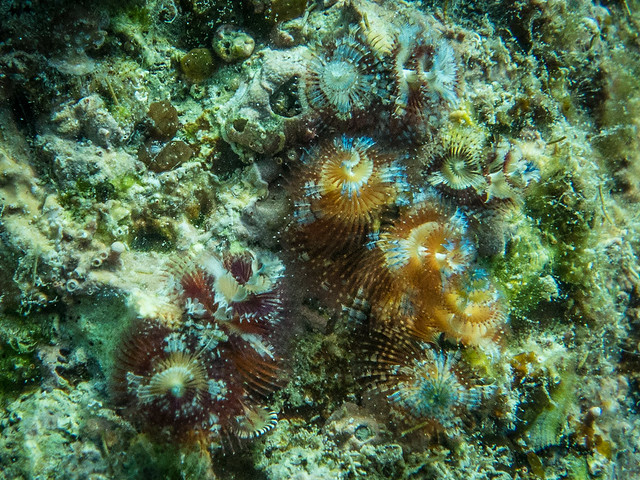
Notice that they always come in pairs. Each pair of "christmas trees" is a single worm.
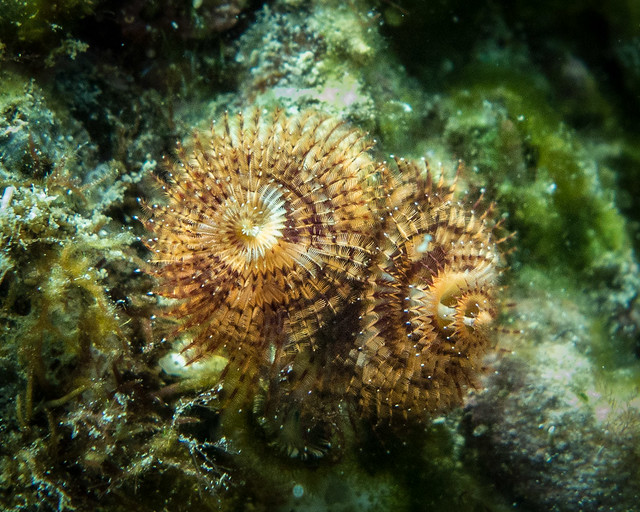
Fan worms are less colorful but the details are amazing when you look close. This one almost looks like feathers. (Some worms are called "feather dusters" due to this resemblance.)
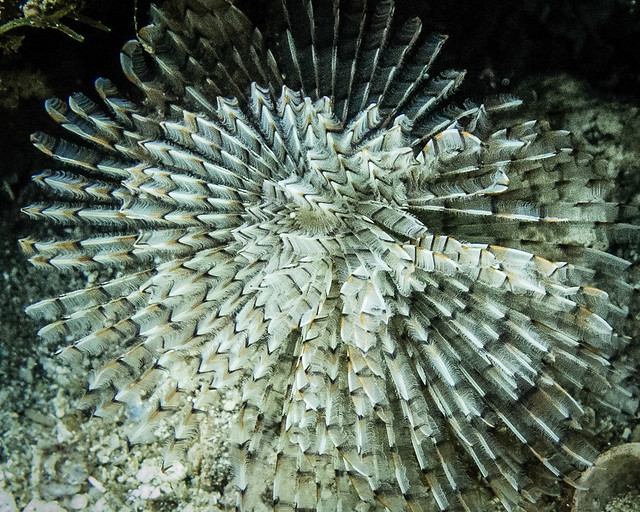
Hopefully the photos have convinced you to look for slugs and worms next time you are snorkelling or diving :-)
Note: color (white balance) is altered underwater and I have adjusted these (raw) photographs to look "correct" as much as I can, but the colors may still not be totally accurate.
Nudibranchs are, roughly speaking, sea slugs. That doesn't sound very exciting if you think of land slugs. But nudibranchs come in an amazing assortment of shapes and colors. A better equivalent might be the butterflies of the sea.
The word "nudibranch" means roughly "naked gills". That's the bushy thing you can see on their backs.


One good thing about photographing nudibranchs is that they don't move too fast. Although even a slow crawl can take them out of sight when you're fiddling with camera settings and trying not to drift away.
This one isn't as sharp as I'd like, but it's the best I got of this type. We didn't see many of these.

It takes skill and experience to spot the nudibranchs, just like an expert birdwatcher will see more birds. Rafael (our dive master) is very good at it. We also had another guy diving with us, John, whose main interest was nudibranchs. Where I might spot one or two on a dive, he would see a dozen different kinds. (He had little interest in boring things like fish!) Rafael and John were also spotting ones that were tiny, e.g. less than a centimeter (half an inch) long. I didn't even try to spot (or photograph) those ones. The ones I have photos of were maybe 5 cm (2 inches).
The Tiger dorid (Roboastra tigris) below is one of the largest, growing up to 30 cm (12 inches) in length. The name fits both the coloring and its predatory behavior. It will even eat other nudibranchs, swallowing them whole.

I shared this photo previously from our earlier dives. This was the only one of this type that we've seen so far.

[update] We saw a couple more of these later. They were "flatter" than the first one.

[update] We also saw a few Agassiz's nudibranchs. I tried to get a better angle instead of straight overhead or from the side.

These next ones are related but they have a partial shell - a cone shaped "hat". They are side-gill snails because they have their gills on one side instead of on top like the nudibranchs. The photo is not the clearest, but there are two of them together, possibly mating?

See all my nudibranch photos from this trip
"worms" doesn't sound very appealing, but Christmas tree worms are beautiful. You don't actually see the worm, just their feeding and respiration structure - a spiral that can be a variety of colors. If you get too close the worms retract this structure instantly, making it tricky to photograph them sometimes - if you get too close you end up with nothing to photograph. A bit of current seems to help, probably because it "hides" your movement.
This blue color is less common but stands out because there aren't a lot of things that color.

They are often found in groups. Sometimes a rock will be covered in them.

Notice that they always come in pairs. Each pair of "christmas trees" is a single worm.

Fan worms are less colorful but the details are amazing when you look close. This one almost looks like feathers. (Some worms are called "feather dusters" due to this resemblance.)

Hopefully the photos have convinced you to look for slugs and worms next time you are snorkelling or diving :-)
Note: color (white balance) is altered underwater and I have adjusted these (raw) photographs to look "correct" as much as I can, but the colors may still not be totally accurate.
No comments:
Post a Comment